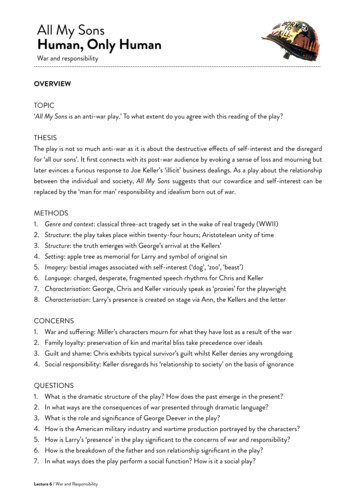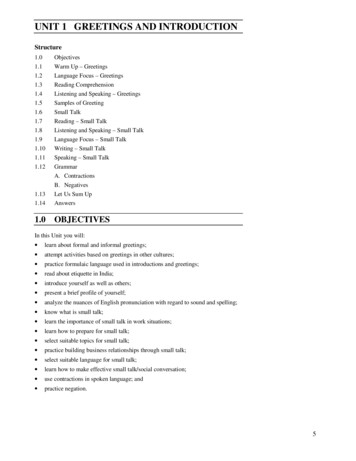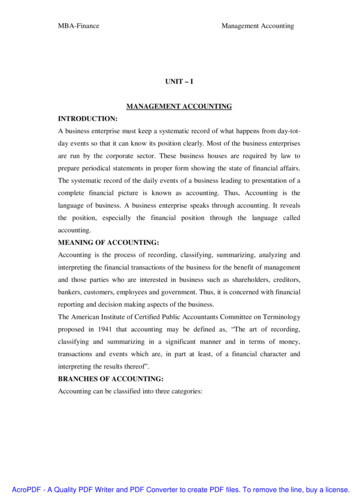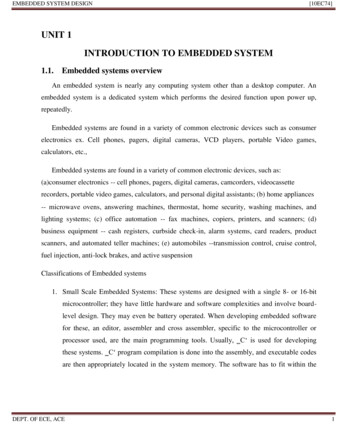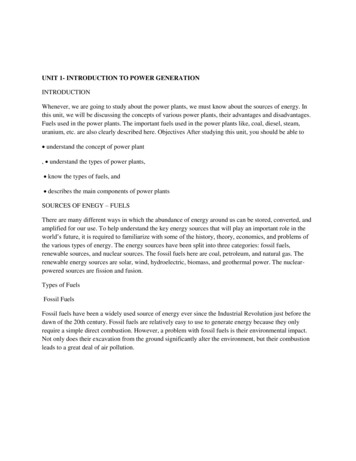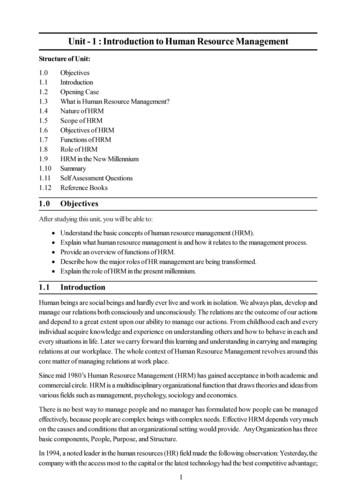
Transcription
Unit - 1 : Introduction to Human Resource ManagementStructure of ectivesIntroductionOpening CaseWhat is Human Resource Management?Nature of HRMScope of HRMObjectives of HRMFunctions of HRMRole of HRMHRM in the New MillenniumSummarySelf Assessment QuestionsReference Books1.0ObjectivesAfter studying this unit, you will be able to: 1.1Understand the basic concepts of human resource management (HRM).Explain what human resource management is and how it relates to the management process.Provide an overview of functions of HRM.Describe how the major roles of HR management are being transformed.Explain the role of HRM in the present millennium.IntroductionHuman beings are social beings and hardly ever live and work in isolation. We always plan, develop andmanage our relations both consciously and unconsciously. The relations are the outcome of our actionsand depend to a great extent upon our ability to manage our actions. From childhood each and everyindividual acquire knowledge and experience on understanding others and how to behave in each andevery situations in life. Later we carry forward this learning and understanding in carrying and managingrelations at our workplace. The whole context of Human Resource Management revolves around thiscore matter of managing relations at work place.Since mid 1980’s Human Resource Management (HRM) has gained acceptance in both academic andcommercial circle. HRM is a multidisciplinary organizational function that draws theories and ideas fromvarious fields such as management, psychology, sociology and economics.There is no best way to manage people and no manager has formulated how people can be managedeffectively, because people are complex beings with complex needs. Effective HRM depends very muchon the causes and conditions that an organizational setting would provide. Any Organization has threebasic components, People, Purpose, and Structure.In 1994, a noted leader in the human resources (HR) field made the following observation: Yesterday, thecompany with the access most to the capital or the latest technology had the best competitive advantage;1
Today, companies that offer products with the highest quality are the ones with a leg up on the competition;But the only thing that will uphold a company’s advantage tomorrow is the caliber of people in theorganization.That predicted future is today’s reality. Most managers in public- and private sector firms of all sizeswould agree that people truly are the organization’s most important asset. Having competent staff on thepayroll does not guarantee that a firm’s human resources will be a source of competitive advantage.However in order to remain competitive, to grow, and diversify an organization must ensure that itsemployees are qualified, placed in appropriate positions, properly trained, managed effectively, andcommitted to the firm’s success. The goal of HRM is to maximize employees’ contributions in order toachieve optimal productivity and effectiveness, while simultaneously attaining individual objectives (suchas having a challenging job and obtaining recognition), and societal objectives (such as legal complianceand demonstrating social responsibility).1.2Opening CaseOn October 3, 2003, Anant Dalvi and Akhtar Khan, who worked as contract workers in Tata ElectricCompany until they were laid off in 1996, doused themselves with kerosene and set themselves ablazeeven as their co-workers protested before the company’s offices. While Dalvi died on the spot, Khandied a few days later.The Tata Electric Company said they were no longer on their payroll and were not permanent workers.Employees union had taken up their case and filled petition in the Labour Court before their contractswere terminated. The court directed the company not to terminate their services without following the dueprocess of law. Despite this their services were terminated on June 30, 1996.The company union promised the workers that they would renegotiate. Yet on the night before they killedthemselves when Khan and Dalvi spoke to the union leader Shinde, they were told that nothing morecould be done for them. It is this that led them to take their lives. Dalvi has been in service as a peon for17years and Khan had been employed for 19 years. But their services were not regularized. Such workersdraw salary much less than the permanent employees.This is an example of the problem that comes under the purview of Human Resource Management- themain concept elaborated in this chapter.1.3What is Human Resource Management?HRM is the study of activities regarding people working in an organization. It is a managerial function thattries to match an organization’s needs to the skills and abilities of its employees.1.3.1 Definitions of HRMHuman resources management (HRM) is a management function concerned with hiring, motivatingand maintaining people in an organization. It focuses on people in organizations. Human resourcemanagement is designing management systems to ensure that human talent is used effectively and efficientlyto accomplish organizational goals.HRM is the personnel function which is concerned with procurement, development, compensation, integrationand maintenance of the personnel of an organization for the purpose of contributing towards theaccomplishments of the organization’s objectives. Therefore, personnel management is the planning,organizing, directing, and controlling of the performance of those operative functions (Edward B. Philippo).2
According to the Invancevich and Glueck, “HRM is concerned with the most effective use of peopleto achieve organizational and individual goals. It is the way of managing people at work, so that they givetheir best to the organization”.According to Dessler (2008) the policies and practices involved in carrying out the “people” or humanresource aspects of a management position, including recruiting, screening, training, rewarding, andappraising comprises of HRM.Generally HRM refers to the management of people in organizations. It comprises of the activities, policies,and practices involved in obtaining, developing, utilizing, evaluating, maintaining, and retaining the appropriatenumber and skill mix of employees to accomplish the organization’s objectives. The goal of HRM is tomaximize employees’ contributions in order to achieve optimal productivity and effectiveness, whilesimultaneously attaining individual objectives (such as having a challenging job and obtaining recognition),and societal objectives (such as legal compliance and demonstrating social responsibility).In short Human Resource Management (HRM) can be defined as the art of procuring, developing andmaintaining competent workforce to achieve the goals of an organization in an effective and efficientmanner.1.4Nature of HRMHRM is a management function that helps manager’s to recruit, select, train and develop members for anorganization. HRM is concerned with people’s dimension in organizations.The following constitute the core of HRM1. HRM Involves the Application of Management Functions and Principles. The functionsand principles are applied to acquiring, developing, maintaining and providing remuneration toemployees in organization.2. Decision Relating to Employees must be Integrated. Decisions on different aspects ofemployees must be consistent with other human resource (HR) decisions.3. Decisions Made Influence the Effectiveness of an Organization. Effectiveness of anorganization will result in betterment of services to customers in the form of high quality productssupplied at reasonable costs.4. HRM Functions are not Confined to Business Establishments Only but applicable to nonbusiness organizations such as education, health care, recreation and like.HRM refers to a set of programmes, functions and activities designed and carried out in order to maximizeboth employee as well as organizational effectiveness.1.5Scope of HRMThe scope of HRM is indeed vast. All major activities in the working life of a worker – from the time of hisor her entry into an organization until he or she leaves the organizations comes under the purview of HRM.The major HRM activities include HR planning, job analysis, job design, employee hiring, employee andexecutive remuneration, employee motivation, employee maintenance, industrial relations and prospectsof HRM.The scope of Human Resources Management extends to: All the decisions, strategies, factors, principles, operations, practices, functions, activities andmethods related to the management of people as employees in any type of organization. All the dimensions related to people in their employment relationships, and all the dynamics thatflow from it.3
Union/LabourRelationsCompensationand agementDesign of theOrganizationand JobOrganizationalDevelopmentSelection andStaffingTraining andDevelopmentFigure 1.1: Scope of HRMThe scope of HRM is really vast. All major activities n the working life of a worker – from the time of hisor her entry into an organization until he or she leaves it comes under the purview of HRM. AmericanSociety for Training and Development (ASTD) conducted fairly an exhaustive study in this field andidentified nine broad areas of activities of HRM.These are given below: Human Resource PlanningDesign of the Organization and JobSelection and StaffingTraining and DevelopmentOrganizational DevelopmentCompensation and BenefitsEmployee AssistanceUnion/Labour RelationsPersonnel Research and Information Systema) Human Resource Planning: The objective of HR Planning is to ensure that the organization hasthe right types of persons at the right time at the right place. It prepares human resources inventorywith a view to assess present and future needs, availability and possible shortages in human resource.Thereupon, HR Planning forecast demand and supplies and identify sources of selection. HRPlanning develops strategies both long-term and short-term, to meet the man-power requirement.b) Design of Organization and Job: This is the task of laying down organization structure, authority,relationship and responsibilities. This will also mean definition of work contents for each positionin the organization. This is done by “job description”. Another important step is “Job specification”.Job specification identifies the attributes of persons who will be most suitable for each job whichis defined by job description.4
c) Selection and Staffing: This is the process of recruitment and selection of staff. This involvesmatching people and their expectations with which the job specifications and career path availablewithin the organization.d) Training and Development: This involves an organized attempt to find out training needs of theindividuals to meet the knowledge and skill which is needed not only to perform current job butalso to fulfil the future needs of the organization.e) Organizational Development: This is an important aspect whereby “Synergetic effect” isgenerated in an organization i.e. healthy interpersonal and inter-group relationship within theorganization.f) Compensation and Benefits: This is the area of wages and salaries administration where wagesand compensations are fixed scientifically to meet fairness and equity criteria. In addition labourwelfare measures are involved which include benefits and services.g) Employee Assistance: Each employee is unique in character, personality, expectation andtemperament. By and large each one of them faces problems everyday. Some are personal someare official. In their case he or she remains worried. Such worries must be removed to make himor her more productive and happy.h) Union-Labour Relations: Healthy Industrial and Labour relations are very important for enhancingpeace and productivity in an organization. This is one of the areas of HRM.i) Personnel Research and Information System: Knowledge on behavioral science and industrialpsychology throws better insight into the workers expectations, aspirations and behaviour.Advancement of technology of product and production methods have created working environmentwhich are much different from the past. Globalization of economy has increased competitionmany fold. Science of ergonomics gives better ideas of doing a work more conveniently by anemployee. Thus, continuous research in HR areas is an unavoidable requirement. It must also takespecial care for improving exchange of information through effective communication systems on acontinuous basis especially on moral and motivation.HRM is a broad concept; personnel management (PM) and Human resource development (HRD) are apart of HRM.1.6Objectives of HRMThe primary objective of HRM is to ensure the availability of competent and willing workforce to anorganization. The specific objectives include the following:1) Human capital : assisting the organization in obtaining the right number and types of employees tofulfill its strategic and operational goals2) Developing organizational climate: helping to create a climate in which employees are encouragedto develop and utilize their skills to the fullest and to employ the skills and abilities of the workforceefficiently3) Helping to maintain performance standards and increase productivity through effective job design;providing adequate orientation, training and development; providing performance-related feedback;and ensuring effective two-way communication.4) Helping to establish and maintain a harmonious employer/employee relationship5) Helping to create and maintain a safe and healthy work environment5
6) Developing programs to meet the economic, psychological, and social needs of the employeesand helping the organization to retain the productive employees7) Ensuring that the organization is in compliance with provincial/territorial and federal laws affectingthe workplace (
Human resources management (HRM) is a management function concerned with hiring, motivating and maintaining people in an organization. It focuses on people in organizations. Human resource management is designing management systems to ensure that human talent is used effectively and efficiently to accomplish organizational goals. HRM is the personnel function which is concerned with .





